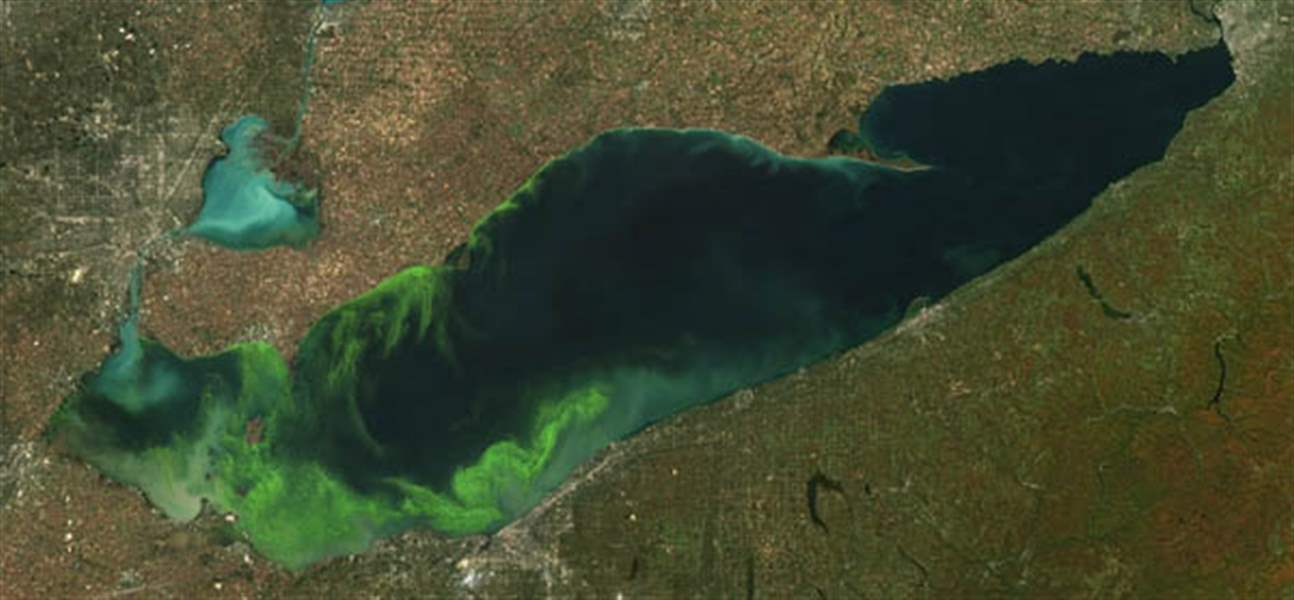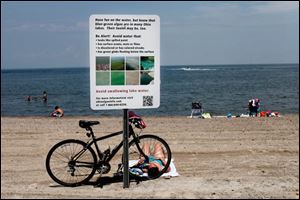
TOLEDO CITY COUNCIL
Toxin to cost Toledo another $1M
Council hikes budget, OKs $6.4M for sewer work, water lines
10/1/2013
Satellite images, credit NOAA Center for Coastal Ocean Science 2011 data from NASA MODIS sensor. 2012 is predicted to have a significant similar in intensity to 2003. The high concentrations would be areas where the bloom would be most evident to a boater. NOT BLADE PHOTO
Not Blade photo CREDIT credit NO

A sign alerts swimmers to the danger of algae this summer.
Toledo City Council unanimously agreed Tuesday to open the city’s wallet and pay $1 million to neutralize a potentially lethal toxin from algae in western Lake Erie that found its way into the city’s water supply.
Council also agreed to spend $6.4 million toward sewer work and water lines for the Lucas Metropolitan Housing Authority’s Collingwood Green Senior Community.
The Bell administration told council last week the city had no choice regarding the extra money to keep tap water safe to drink.
David Leffler, commissioner of operations at the Collins Park Water Treatment Plant, said toxins may linger in the water, possibly for weeks or longer, after algae normally fades from sight in mid-October. Toledo’s budget for chemicals to treat drinking water was $3 million this year. A similar $1 million increase was needed in 2010, when the budget for chemicals was $2 million.
Council also authorized the Bell administration to spend $100,000 toward a planned expansion of the Collins Park Water Treatment Plant in East Toledo.
The $58 million Collingwood Green project will create a total of 272 units of mixed-income and seven market-rate housing. The first phase of 65 units is finished.
“This infrastructure will include new roadways, sidewalks, water lines, sanitary sewer lines, storm water-system improvements and the renovation and/or removal of existing infrastructure where necessary,” according to the city legislation.
To pay for separating combined storm-water drains from Toledo’s sewer system, the city will borrow more than $5.5 million from the Ohio Water Development Authority. Council authorized spending $622,000 for new water lines from the city’s water infrastructure development fund, and $215,000 for new sewer lines from the sanitary sewer infrastructure development fund.
“It is not unheard of, when you have new development going into an aging neighborhood, to upgrade the infrastructure,” city spokesman Jen Sorgenfrei said.
The city has done similar upgrades for industrial sites such as the Jeep plant or other residential developments, Ms. Sorgenfrei said.
In other business, council voted 12-0 for a zoning change that paves the way for a 596-bed student apartment complex near the University of Toledo. NRP Group LLC of Cleveland plans to build a 200-unit, off-campus student housing project at the southeast corner of Dorr Street and Westwood Avenue.
Council also voted 12-0 to oppose a proposed deep geological repository for low and intermediate-level radioactive wastes near Kincardine, Ont., or any other underground repository near the shores of any Great Lake or connecting waterway. The resolution urged Canadian officials to find alternatives to Ontario Power Generation’s proposal to bury nuclear waste in the Great Lakes Basin watershed.
Contact Ignazio Messina at: imessina@theblade.com or 419-724-6171 or on Twitter @IgnazioMessina.